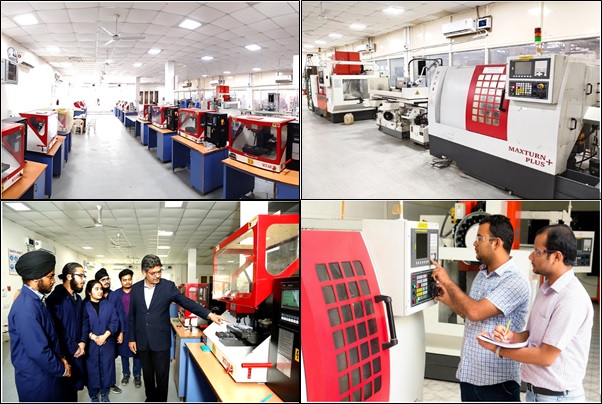
STAFF:
List of Machinery:
|
Make / No. of Machines |
MTAB / 07 |
|
Model |
XL MILL |
|
Title of the related experiment: |
To develop a component for a given part program using an Aluminium billet. |
|
A brief explanation of the usage of the said equipment |
The computer numeric control milling machine is a trainer having a stepper motor (for axes) and AC motor (for spindle), that can be used to perform a variety of operations such as face milling, side milling, T-Slot milling and end milling, drilling, reaming, pocketing, roughing and chamfering the rectangular workpieces. It is a 3 – axis bench milling machine, the X-axis and Y-axis designate horizontal movement (side-to-side and forward-and-back, respectively, on a flat plane), while the Z-axis represents a vertical movement (up-and-down). It has a 6-station ATC and a controller. With this setup, students should be able to: · Feed the program in the control panel of the CNC milling machine. · Develop the skill of offsetting different tools. · Know how to run the machine. · Analysis of the effect of various parameters such as feed, and depth of cut on the component and tool while machining. · Develop the components for a given part program. |
2.CNC Lathe
|
Make/ No. of Machines |
MTAB / 07 |
|
Model |
XL TURN |
|
Title of the related experiment: |
Machining of an Aluminium cylindrical billet for a given part programming |
|
A brief explanation of the usage of the said equipment |
CNC Lathe is a trainer with a stepper motor (for axes) and AC motor (for spindle) that can be used to perform a variety of operations such as turning, boring, threading, grooving, parting, drilling etc. It is a 2 - axis slant bed lathe in which X-axis represents the diameter and Z-axis represents the length. It feeds the cutting tool in a linear motion along the surface of the rotating workpiece, removing material around the circumference until the desired diameter is achieved i.e., to produce cylindrical parts. It has eight stations (programmable) turret (ATC) with four sleeves for internal tools and four stations for external tools with a controller. With this setup, the students can able to · Feed the CNC program in the control panel. · Develop the skill of offsetting of different tools. · Know the proper functioning of the CNC turning. · Carryout various machining operations such as turning, drilling threading etc. · Develop a component for a given part program. |